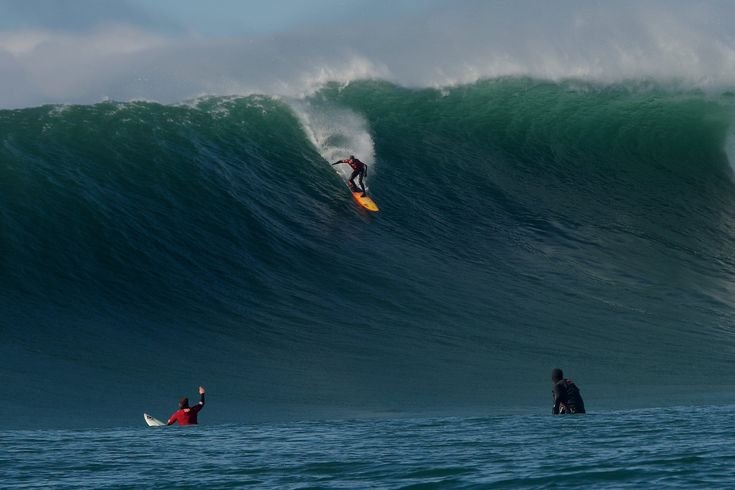Imagine standing on the edge of an endless expanse of water, feeling the salty mist against your skin and hearing the rhythmic crashing of waves. It is in this moment that surfers find their sanctuary, a place where they can tap into the raw power of nature and ride along its magnificent swells.Surf camps have become increasingly popular among surf enthusiasts of all levels, and for good reason. These specialized camps provide a unique opportunity for surfers to not only improve their skills in the water but also immerse themselves in the vibrant culture and lifestyle that surrounds the sport. But what exactly is it about surfing that captivates so many? Beyond the thrill and exhilaration lies a complex science that unlocks the secrets of wave dynamics and human interaction with these aquatic giants. In this article, we will delve deep into the fascinating world of surfing, exploring how understanding waves can help us unlock their potential and ride them like never before.
Understanding Wave Height, Period, And Shape
Understanding wave height, period, and shape is paramount for any aspiring surfer looking to dominate the swells. Wave height refers to the vertical distance between the lowest point of a wave (the trough) and its highest point (the crest). It determines how big and powerful a wave will be, dictating the level of adrenaline rush surfers can expect. But it’s not just about size; wave period also plays a crucial role.
Wave period refers to the time it takes for two successive crests or troughs to pass through a fixed point in space. This measurement indicates how often waves are created by natural forces in a specific area. Longer periods generally signify larger distances between successive waves, creating clean breaks that allow surfers more time on each ride. Conversely, short-wave periods make close-set waves that result in rapid-fire breakers that challenge even experienced surfers.
The Role Of Tides In Surfing Conditions
The role of tides in surfing conditions is a crucial yet often overlooked aspect for both beginner and experienced surfers. Tides have a significant impact on the quality and size of waves, making them an essential factor to consider when planning a surf session. While waves can be found during any tide, understanding how tides affect the surf break can greatly enhance your surfing experience.
- Tides are primarily determined by the gravitational pull of the moon and sun on our oceans. As these forces change in intensity throughout the day, they create variations in water levels. The two main types of tides that surfers need to familiarize themselves with are high tide and low tide. High tide occurs when the water level is at its highest point, while low tide represents the lowest water level. These different tidal conditions cause waves to break differently depending on the depth and shape of the seafloor, which ultimately affects surfing conditions.
- For instance, during high tide, waves tend to break closer to shore since there is less exposed sandbars or rocks beneath them. This results in shorter rides but provides more steepness, which is ideal for maneuvering tricks like cutbacks or aerials. On the other hand, during low tide when more parts of sandy or rocky bottoms get exposed due to decreased water levels; waves generally mush out and become slower as they encounter shallow areas.
How Surfers Harness The Power Of Waves
Surfing is more than just a sport; it’s an art form that allows individuals to connect with nature and harness the immense power of waves. Surfers have an innate ability to read the ocean and predict where the best waves will break, enabling them to position themselves perfectly for action. This level of skill isn’t just about timing and luck, but rather a deep understanding of wave mechanics.
To truly ride a wave, surfers must immerse themselves in its energy, tapping into its force through precise body movements and weight distribution. By directing their weight forwards or backward on their board, surfers are able to generate speed or control their trajectory with incredible precision. It’s this dance between surfer and wave that creates such a mesmerizing spectacle for both participants and observers alike.
What makes surfing even more fascinating is that every wave is unique; no two waves are ever exactly the same. Surfers must adapt constantly to changing conditions, adjusting their technique depending on swell direction, the shape of the wave, currents, wind speed, and countless other factors. This dynamic interaction between surfer and the environment adds an element of unpredictability that keeps surfers continuously challenged in mastering their craft.
Conclusion:
At first glance, surfing may seem like just a sport or a recreational activity. But for those who truly understand its essence, surfing is more than just riding waves. It is an art form, a graceful dance on water that connects the surfer with the very forces of nature. It is also a science, as surfers rely on their understanding of wave patterns, tides, and wind conditions to make split-second decisions and ride the perfect wave. This newfound respect instills a sense of responsibility towards protecting our oceans and becoming better stewards of our planet as a whole. Mission Beach surf lessons provides not only an incredible platform for learning how to surf but also an avenue for personal growth and environmental awareness – making each surf lesson at Mission Beach truly remarkable.
Beyond the physical aspect of surfing lies a spiritual connection to something greater than ourselves. Surfers often describe an indescribable sense of freedom and peace while gliding across the water. At that moment, they are one with the ocean and all its power, experiencing a pure state of flow that transcends everyday worries and stresses.
Surfing also teaches us about adaptability and resilience. Each wave presents a different challenge that requires quick thinking and adjustment. Surfers learn how to read the ocean’s ever-changing moods and respond accordingly. They embrace failure as an opportunity for growth and strive to constantly improve their skills.
In conclusion, surfing encompasses both artistry and scientific knowledge intertwined in harmony. It offers not only physical agility but also emotional rejuvenation and mental fortitude. Whether you are standing on your board for the first time or have been riding waves for years, there is always something new to discover in this exhilarating blend of art and science known as surfing.




